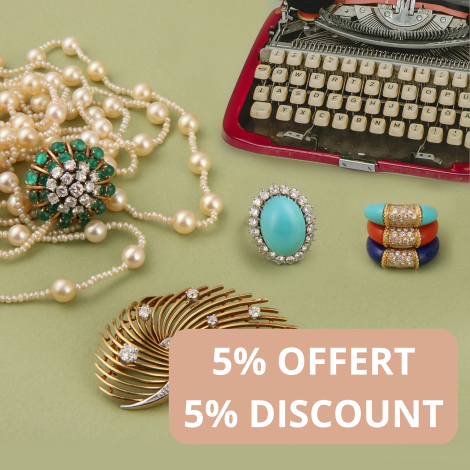Belle Époque jewellery: the fascinating history of jewellery
Belle Époque, also known as the Art Nouveau movement, began at the end of the 19th century in Europe and particularly in Paris. Revolutionary and innovative in many ways, it was a period of abundant creativity and saw the emergence of a new artistic production among jewellery designers. Precursor and avant-gardiste, Belle Époque jewellery is incredibly original and inventive. What are the origins of the creation of necklaces, pendants, brooches, rings and earrings at the end of the 19th century? Let us tell you about the fascinating history of Belle Époque jewellery.
Historical reminder: What is the Belle Époque?
A few dates and a bit of history
The Belle Époque, a prosperous and exciting period, lasted from the end of the 19th century until 1914. Between the end of the Franco-Prussian War of 1870 and the beginning of the First World War, Europe experienced a period of peace and prosperity favourable to economic and technical progress, as witnessed by the Paris World Fairs of 1889 and 1900, which were great showcases. The population was full of optimism and not concerned about the future. The atmosphere of the Belle Époque was felt above all in urban areas and in the major European capitals. The energy that animated social, cultural and artistic life was as joyful as it was exciting.
The art of the Belle Époque
Belle Époque is a period rich in creativity during which Art Nouveau was emerging. Art developed at a high speed thanks to artists such as Picasso, Renoir or Van Gogh for example. A new style appeared, leaving its mark in all artistic fields, from music to sculpture, architecture, tapestry or decorative art. The flowers of master glassmaker and ceramist Émile Gallé and the famous Parisian underground stations of Hector Guimard, picturesque jewels of Art Nouveau, are the perfect illustration of this.

The art of jewellery during the Belle Époque
Belle Époque still fascinates today with its sulphurous courtesans, its sumptuous lifestyle and above all the jewellery and high jewellery which settled in Place Vendôme at that time. Fréderic Boucheron chose the "Hôtel de la Comtesse de Castiglione": the courtesan lived on the top floor of the 26 Place Vendôme. Many jewellers followed and settled there: Chaumet, Cartier, Van Cleef & Arpels… Their clientele was nobility and bourgeoisie, but it was above all the courtesans, embellished ambassadors, who set the trend of la Belle Époque, which bears its name well, being sumptuous and seductive. For example, La Belle Otéro was only faithful to Cartier jewellery as well as Liane de Pougy (her greatest rival), La Païva or even Valtesse de la Bigne. Today, these figures of courtesans still fascinate. In 2007, in Geneva, two sumptuous yellow diamonds that belonged to La Païva, one pear-shaped of 82-carat and a cushion-shape of 102-carat sold for 3.5 and 5 million Swiss francs respectively.

Characteristics of Belle Époque jewellery
Inspired by the numerous artistic innovations of that time, the Belle Époque jewellers marked their jewellery creations by representing nature and women. Very avant-garde, Art Nouveau jewellery cheerfully celebrated fauna et flora: it's recognisable thanks to their curved lines, their natural forms and their evocation of magic and fairy tales, for example the famous dragonfly woman of the jeweller René Lalique remains one of its greatest symbols. Pendants and brooches were legion during la Belle Époque, as their surface area is larger to showcase artistic representations, offering their creators the opportunity to give free rein to their overflowing imagination. There are therefore a large number of Art Nouveau brooches or pendants depicting female faces with the body of a dragonfly or insect.
Belle Époque jewellery is set in gold, platinum and sometimes silver, set with old-cut diamonds, precious stones (it was the great return of the opal) or pearls (often fine). Some unexpected materials also make their appearance, such as horn, tortoiseshell, exotic woods, mother-of-pearl and especially enamel. Most of the motifs were ribbons, knots or crosses… We then find swirl rings, "toi et moi" rings or necklaces that can be transformed into brooches.


Belle Époque rings
Daisy rings, cameo rings or enamel rings, the Belle Époque rings, very appreciated and sought-after today, are a beautiful legacy of the creative vitality of this period. Harmoniously blending classical style and modernism, late 19th century rings are often of sumptuous beauty. Although yellow gold remains dominant in ring creations, jewellers did not hesitate to marry it with silver or platinum, a precious metal that gradually became very fashionable. A few juicy anecdotes circulate about Belle Époque rings, such as the creation of so-called “erotic” rings, intended for dandies, representing the bodies of naked women. It is also said that the famous spy and dancer Mata Hari hid a powerful aphrodisiac in the dome of a poison ring. It is said that she used it to extract highly confidential information from the men she was seducing.
Precious stones in fashion during the Belle Époque
1900 jewellery is highly sought after by collectors of old jewellery, as it is relatively rare. Indeed, the Belle Époque was an intense but relatively short period: the production of jewellers was therefore limited. Moreover, their finesse and age gave them a fragility that encourages to keep them hidden rather than to wear them.
The heyday of the French colonial empire facilitated the trade in rare and precious materials. Many gems were therefore found in the manufacture of Art Nouveau jewellery: diamonds, rubies, sapphires, emeralds, platinum, gold, silver… The exploitation of the mines in South Africa towards the end of the 1860s made it possible to easily obtain supplies of high quality diamonds. Diamonds therefore remained the stone of choice for the manufacture of rings at the end of the 19th century.
Sale and free valuation of Belle Époque jewellery in Paris
If you are interested in Belle Epoque’s jewels, don’t hesitate to discover what Les Pierres de Julie offer in our store…
We are also available for any free expertise of your vintage jewelry, for that you can send an email with your photos to contact@lespierresdejulie.com.
Whether you're interested in buying a piece of jewellery or a stone, a free jewelry appraisal or jewelry resale, Pierres de Julie welcomes you to its Parisian boutique in the Village Suisse, a stone's throw from the Ecole Militaire and the Esplanade des Invalides.
Nouveautés
- 18.000 €
- 18.000 €
- Unit price
- / per
- 1.800 €
- 1.800 €
- Unit price
- / per
- 1.950 €
- 1.950 €
- Unit price
- / per
- 5.950 €
- 5.950 €
- Unit price
- / per












